
Copyrighted Material
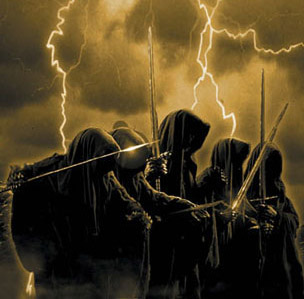
Tolkien at the End of Time;
Alchemical Secrets of The Lord of the Rings
By Jay Weidner and Sharron Rose
By the time Ar-Pharazôn, the twenty-fifth King of Númenor
came to power, the Númenóreans had established
great settlements upon Middle-earth and set themselves up
as Kings and Lords of Men. But all this time, the influence
of the Dark Shadow began to spread over Middle-earth, for
even though Melkor had been physically imprisoned in the Void,
his will remained active and the seeds of corruption he had
planted continued to grow in his followers and especially
his servant Sauron who, in this Second Age of Middle-earth,
created and began to wield the One Ring, binding many to him.
Hearing of Sauron's growing threat, desiring to have power
and dominion over Middle-earth for himself, Ar-Pharazôn
decided to make war upon Sauron and to take Sauron as his
own servant.
Seeing the might of Númenor arrayed against him, Sauron
who still retained beauty of form, power of persuasion and
immense knowledge of the Black Arts, cleverly allowed himself
to be taken hostage and brought to the great kingdom where
after three years he had ingratiated himself with Ar-Pharazôn
to the extent that he became the closest of the his counselors.
Perceiving the desire for immortality, which lay at the core
of the Kings discontent, Sauron spoke to him of the powers
of Melkor the Dark Lord who could offer power beyond that
of the Valar. Such was Sauron's gift of persuasion that Ar-Pharazôn
turned his kingdom to the worship of Melkor and the dark,
building a great temple where ghastly sacrifices were made
to Melkor so that he should release them from Death. But Death
did not depart from the Númenóreans, in fact
amidst this evil it came sooner and a great madness came over
the land. Ar-Pharazôn, now fully under the influence
of Sauron, decided to sail to the land of the immortals to
make war upon them. But as in every Age, the forces of goodness
and truth still lived in the hearts of some. These were the
ancestors of Aragorn, known as the Faithful. Amandil, their
leader bid his family, Elendil, Isildur and the Faithful to
collect all the artifacts, heirlooms, books and treasures
created in the days of wisdom and take them onto great ships
and sail from Númenor.
It was at this time as the prayers to the Dark Lord increased
and Ar-Pharazôn and his fleet moved Westward to the
Blessed Lands, terrible storms and earthquakes appeared in
Númenor. And at the moment he stepped upon the shore
of Valinor, the Creator
"showed forth his power and changed the fashion of
the world; a great chasm opened in the sea between Númenor
and the Deathless Lands, and the waters flowed down into it."
21 In their ships the Númenóreans
were drawn into the abyss. As in the legend of Atlantis, Númenor
itself was overtaken by a great wave and disappeared forever.
The shape of the world was changed. The sight of the Blessed
Lands of the immortals was removed from the Earth. The Earth
became round and Men could only travel within its circles,
never again physically perceiving what Tolkien refers to as
the 'Straight Way'.
It is interesting to note that the information decoded from
the Cross of Hendaye parallels this imaginative vision of
human history. Dividing time into four sections of about 6,500
years each, the cross also bears an inscription that leads
one to discover the origins of Atlantis at Teohuanoco in Bolivia.
As documented in The Mysteries of the Great Cross of Hendaye,
Bolivian professor Arthur Posnansky examined the ancient ruins
there and concluded that they were built around 13,000 B.C.
The high waters of Lake Titicaca bear deep-sea creatures.
If the end of the Second Age was 13,000 years ago, then it
is possible that the ancient civilization that occupied Peru
was somehow wiped out during the shift from the Second to
the Third Age of the precession of the equinoxes. 22
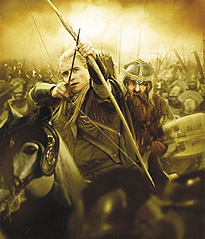
The Third Age of Middle-earth
This is the age of the Great War of the Rings, as documented
in The Rings Trilogy. It begins with the founding of
the Kingdom of Gondor by the Faithful of the Númenóreans,
the defeat of Sauron and the taking of the One Ring by Isildur.
It concludes with the destruction of the Ring of Power and
the coronation of Aragorn as King of Middle-earth. This signals
the end of the Third Age and third phase of the bid for ultimate
power by the forces of evil.
In each Age, these opposing forces are pitted against each
other and ultimately a great battle ensues between them, which
becomes the transitional phase between one Age and the next.
There is a simultaneous cleansing of the world and suppression
and binding of the manifestation of evil. At the same time
at the end of each Age there is a separation or veil that
arises and the pure lands of the Gods and immortals disappear
from the sight of those beings who still dwell in Middle-Earth.
In Tolkien's cosmology, as in the Alchemical and Tantric
teachings on the Ages the veils between the worlds of spirit
and matter grow ever denser as the ages unfold. With the fall
of Númenor (Atlantis), at the end of the Second Age,
Tolkien tells us,
"there is no visible dwelling of the divine or immortal
on earth. Valinor , the dwelling place of the gods (or Paradise)
is removed, remaining only in the memory of the earth."
Men may now sail West as far as they may but will return
only into the east and so back again. For the world is round
and finite, [like the Ring] -a circle inescapable save
by Death. Only the 'immortals', the lingering Elves, may still,
if they will, wearying of the circle of the world, take ship
and find the 'Straight Way', and come to the ancient or True
West and be at peace." 23
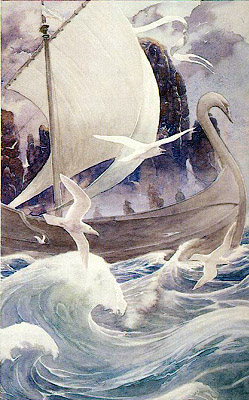
According to The Lord of the Rings and
The Silmarillion, each group of sentient beings that
inhabit Middle-earth not only has a place but also a time.
As the Third Age ends, Tolkien makes it quite clear that the
Age of the fantastic beings that occupy Middle-earth, the
Elves, Dwarves, Wizards and more is also ending. The 'immortal'
Elves are heading for the West and 'fading' from the sight
of humanity. In alchemical terms this means that they are
leaving this plane of existence. The Elves are not leaving
Middle-earth because they want to, they are exiting this mortal
plane because they have no choice. And so Men are left alone
at the end of the book. They have learned the ways of war,
the ways of metallic magic we call Alchemy through Sauron
and Saruman's cunning. It could even be argued that the purpose
of Sauron's war was to destroy the world of Men and forestall
the oncoming Iron Age and to attempt to abort the final dissolution
of the Third Age. In this context, the Great War of the Ring
is not so much the genocide of Men, but a struggle by a mighty
sorcerer to halt the inevitable approach of the dreaded Iron
Age.
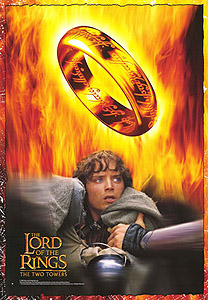
Magic, and the Machine
Sub-creation, the 'Fall', and The Ring of Power
"Anyway, all this is mainly concerned with the Fall,
Mortality and the Machine.. With the Fall inevitably, and
that motive occurs in several modes. With Mortality, especially
as it affects art and the creative (or as I should say sub-creative)
desire. This desire is at once wedded to a passionate love
of the real primary world, and hense filled with the sense
of mortality, and yet unsatisfied by it. It has various opportunities
of 'Fall'. It may become possessive, clinging to the things
made as' it's own', the sub-creator wishes to be the Lord
and God of his private creation. He will rebel against the
laws of the creator especially against mortality. Both
of these (alone or together) will lead to the desire for Power,
for making the will more quickly effective, - and so to the
Machine (or Magic).
-J. R.R. Tolkien, The Letters of J.R.R.Tolkien
Here we come upon another major theme found in Tolkien's
work the relationship between Creation, Art, desire,
power and immortality. True adepts from the great esoteric
traditions of humanity speak of the trap of personal power
and the grasping nature of the individuated ego that desires
its own dominion and therefore, immortality above all else.
For as the adept, spoken of in the alchemical lore as the
artist and imitator of Nature and the divine Great
Work, rises in knowledge and aptitude, as he/she delves into
the heart of nature and the elements, seeking the elusive
prima materia, philosophers stone, and 'elixir of life', there
is always the opportunity for a 'fall' or error. Too often,
like the wizard Saruman in The Rings Trilogy, the aspiring
adept becomes the victim of a type of mental distortion and
disequilibria, which Tolkien describes as a perversion of
their Art into Power. Seduced and perverted by his/her ever
growing communion with 'forces' that promise endless treasures,
extraordinary physical and psychic abilities, power over men
and 'phenomena', and of course, immortality, the alchemist,
having forsaken the essential interior or spiritually oriented
aim of this Divine Art becomes ensnared in an ever-tightening
net of darkness and delusion that is essentially antithetical
to the ultimate goal of the Great Work.
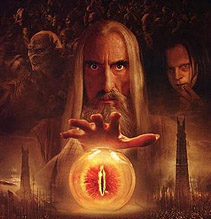
Tolkien tells us that the Elves are placed in
his works to demonstrate the difference between pure unsullied
magic and what we refer to as black magic or sorcery. He states
that their 'magic' is Art, "delivered from many of
its human limitations; more effortless, more quick, more complete
(product and vision in unflawed correspondence). And its object
is Art not Power, sub-creation, not domination and tyrannous
re-forming of Creation." 24
Here let us spend a moment on the subject of the Magical
Arts. Magic in its essential form is the communion and resonance
with and phenomenal display of a spiritual power, energy or
force. At its root it is a pure unsullied creative force.
In Tolkien's world, as in our own, since the time of the first
'fall' there have been two main opposing streams of this 'sub-creative'
magical force. The first is the development of innate powers
or talents for the purpose of a growth and flowering of the
original seed essence or pure vision of the Divine. This magic
or Art, filled with divine light and healing power is that
of those whose hearts remain true to the light such as Galadriel,
Elrond, Gandalf, and Aragorn. The second and contrary stream
as defined by Tolkien is "all use of external plans
or devices (apparatus) instead of developments of these inherent
inner powers or talents - or even the use of these talents
with the corrupted motive of dominating; bulldozing the real
world, or coercing other wills." 25 This
is the dark magic of the Machine, the black magic of Sauron,
and all those beings that he bred through genetic manipulation,
or the corrupted magic of the Elves, Men and Wizards, whose
minds they poisoned and swayed with their dark nefarious promises
and temptations.
Masters of all great initiatic traditions such
as Alchemy tell us that the acquisition of 'the dark powers'
such as demonstrated by Sauron and Saruman are but a distraction
that divert him/her from the true goal of gnosis, communion
and reunion with the Divine Source. Yet, as one gains in knowledge
and power, as one comes to understand the essence of the forces
of creation, there is always the lure of the darkness and
the time of testing. Tolkien, in the Fellowship of the
Ring, illustrates this test that ultimately exists for
each one of us with every choice that we make. For, having
been gifted with 'free will' like the characters of the Ring
Trilogy, it is up to us to choose which path we will follow.
Galadriel, who has taken part in the drama of the Earth since
the Elder Days of the First Age, is given the ultimate test
of her devotion to the Divine Path of the Light, when she
is offered the Ring by Frodo in The Fellowship of the Ring;
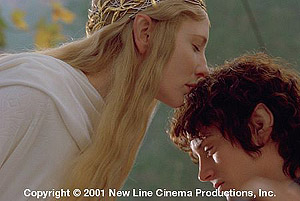
" For many long years I had pondered what I might
do, should the Great Ring come into my hands. And now at last
it comes. You will give me the Ring freely!"
But having contemplated the possible results of this situation,
having seen firsthand the horrific results of this type of dark
magic, she recognizes the spiritual corruption that possession
of the Ring would bring her;
"In place of the Dark Lord you will set up a Queen.
And I shall not be dark but beautiful and terrible as the
Morning and the Night! Fair as the Sea and the Sun and the
Snow upon the Mountain! Dreadful as the Storm and the Lightening!
Stronger than the foundations of the Earth. All shall love
me and despair!"
Galadriel makes her choice - to align herself
with the forces of universal beauty and harmony. It is a selfless
and melancholy choice for she knows that with this choice
her time in Middle-earth will be at its end. Now she will
diminish, go into the West and 'fade'.
Throughout alchemical lore one finds story after story of
this type of testing of the adept. As the Ages unfold and
the forces of darkness and densification spread, there are
constant warnings given concerning the use of power for personal
gain. The seduction of the Satanic forces and the implanting
of the desire to close oneself to wonders of the world of
spirit and reign supreme in the material world are recurrent
themes in the literature. The agonizing results of corruption
of the soul of the adept by the dark powers are constantly
elucidated. This degeneration in our current Age of a deeply
spiritually oriented and genuine sub-creative Art, handed
down through the Ages from Master to student in an unbroken
line of transmission into a mere display of power and dominion
over the forces of nature for personal benefit and aggrandizement,
is what has given the Great Art of Alchemy such a negative
connotation in some circles.
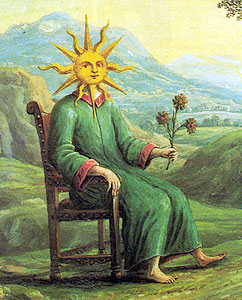
But for the true alchemical adept, turning lead into gold
is merely a metaphor for the process by which the lead or
prima materia of the psychophysical body is transformed into
the pure gold of enlightenment, in which the adept comes into
total alignment and harmony with the Divine. Genuine masters
and adepts who, as a by-product of their devotion to Divine
Principles and 'inner' spiritual work have acquired certain
powers that we would call magical or miraculous, refrain from
exhibiting these powers except under the most serious of circumstances.
Why is it that Galadriel, Gandalf , Elrond, Aragorn and Faramir
refuse to take up the Ring? Filled with wisdom, love, and
virtue, they know in the depths of their beings that their
task is to be of service to the continuance of the ever-unfolding
vision and laws of the One True Creator.
Previous
-|- Page 1 -|- Page
2 -|- Page 3 -|- Page
4 -|- Page 5 -|- Page
6 -|- Page 7 -|-Next
|



